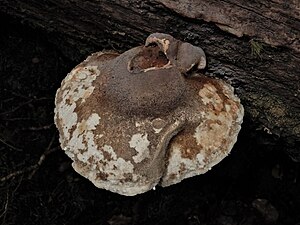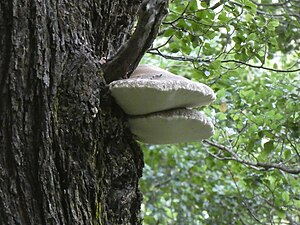|
Laetiporus portentosus
Laetiporus portentosus is a species of polypore fungus in the family Fomitopsidaceae, found in South America, Australia, and in the North Island and northern South Island of New Zealand.[1] NameL. portentosus is known in Māori as pūtawa or pangu, and European settlers (Pākeha) called it "beech whiskers", "beech beard", or "morepork bread".[2] It was also referred to as "punk", a general term for any Polyporus fungus dried and used as tinder.[3] DescriptionThe fungus is a yellowish or white flattened bulbous mass, with a consistency like expanded polystyrene when it is dry, but soft like a sponge when it is thoroughly wet, with a light brown top and paler underside with very small but visible pores, 1–3 pores/mm. Often enough, the mass is thoroughly eaten by grubs, till it looks like a sponge.[4][2] Usually found several metres above ground, it grows 10–30 cm across and up to 6 cm thick.[1][4] EcologyIn New Zealand this species in Māori tradition was associated with the small tree hutu (Ascarina lucida), so much so that it was known as ngā huruhuru o hutu waewae – "the hairs on the legs of hutu".[2] In New Zealand it is also found on southern beech (Nothofagus) trees.[3] The white-throated treecreeper (Cormobates leucophaea) has been recorded feeding on this fungus in a heathy dry forest in Victoria.[5] In a study comparing different fungi that inhabit wood, it was found that L. portentosus had a high ability to decompose heartwood and a low ability to decompose sapwood of Nothofagus pumilio.[6] TaxonomyThe fungus was first described in 1844 by English mycologist Miles Joseph Berkeley. Mario Rajchenberg transferred it to the genus Laetiporus in 1995, based on morphology, but in a 2008 molecular phylogeny L. portentosus fell well outside the core Laetiporus clade, suggesting Laetiporus is polyphyletic and more gene regions needed to be sequenced to resolve this.[7][8] The fungus has acquired an extensive synonymy in the interim:[9]
Cultural usesL. portentosus has been used traditionally as tinder and for carrying fire by both Australian Aboriginals[10] and New Zealand Māori people; when dried and set alight, the fungus will smoulder very slowly, and could be used as a reliable source of ignition.[3] Smouldering pieces were half-buried in the ground (where they would burn for a day or two), carried from place to place in ornately-carved tinderboxes, or placed atop a stick and used to light one's way when travelling at night.[2] Pākehā also used pūtawa as a fire starter, a substitute for touchpaper, carrying it around in cigarette tins; it was even sent with flint stones to New Zealand troops in both World Wars to help light cigarettes and pipes.[2] Māori used pūtawa cut into absorbent strips and bandaged around wounds to protect them from pressure.[2] It was also possibly taken internally "to soften and ease a difficult labour."[3][11] Gallery
References
External links
|
||||||||||||||||||||||||||||
Portal di Ensiklopedia Dunia



